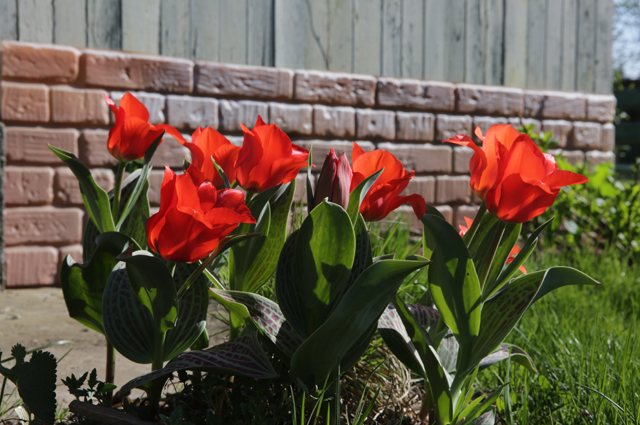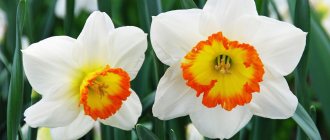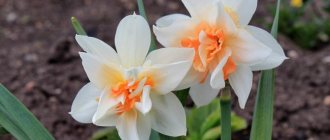The most unpretentious bulbous plants that are deservedly popular with flower growers in our country are daffodils. These flowering plants can be cultivated not only in sunny but also in shaded areas.
It is safe to say that even inexperienced flower growers manage to plant such plants, as well as grow them. Planting bulbs is allowed not only before winter, but also in early spring. Planting material can be planted as soon as the ground in the flower beds warms up and thaws to a depth of at least 20 cm.
Is it possible to plant daffodils in spring
If all the dates for the autumn planting are missed for some reason, you can save the planting material for several months and plant the daffodil bulbs in the spring. Planting daffodils in the spring has minor differences from the autumn planting. If it is necessary to plant daffodils in the spring, you should know the answers to the questions: when can you plant the bulbs of such plants in the spring in open ground and how to properly preserve the planting material before planting in flower beds or flower beds.
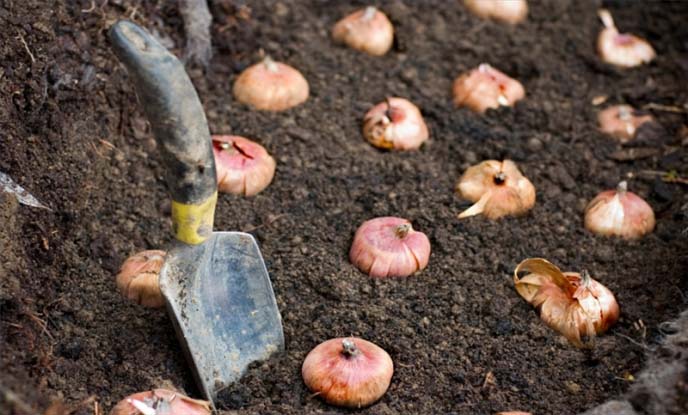
The best tulip varieties for growing in the garden
Before planting tulips, choose the right varieties according to their height, external shape and flowering time. In most species, flowering occurs in late spring and lasts up to 25 days.
In landscape design, about 300 different types of tulips are used, the flowers of which are incredibly diverse in the shape of the buds: rounded, bell-shaped, narrowed, peony, star-shaped, fringed, double and lily-colored. All varieties can be divided into 4 groups according to their decorative characteristics:
1. Early flowering (late April). Varieties - Christmas Marvel, Purple Prince, Abba. Looks great in the foreground in flower beds and around curbs.
2. Medium flowering (early May). Varieties - Triumph, Golden Apeldoorn, Pink Impression, Judith Leyster, Happy Generation. They are massively used to decorate flower beds with tulips in city gardens and parks.
3. Late flowering (late May). Varieties - West Point, Marilyn, Menton, Queen Of Night, Uncle Tom, Blue Diamond, Carrousel, Lambada, Texas Flame, Texas Gold, Green Wave. Widely used in any planting style.
4. Species and wild-growing. Varieties - Calypso, Tarafa, Turkestan tulip. Looks great on alpine slides and rockeries. Usually they are used in the Art Nouveau style, a rather non-standard approach to landscaping the site.
You may be interested in: Planting tulips in bulb baskets
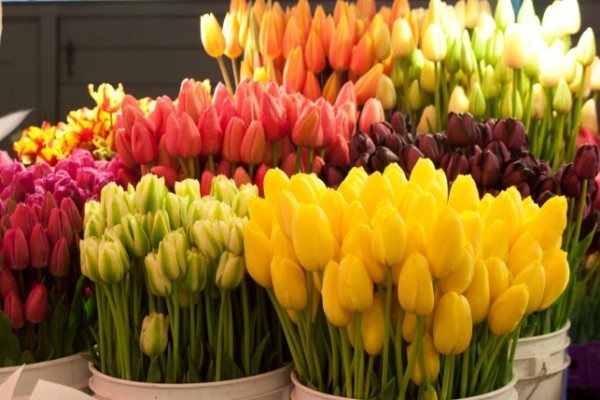

How to plant daffodils in spring
Usually, experienced florists are guided by the following agrotechnical techniques that help preserve planting material in the presence of recurrent frosts and increase the germination of plants:
- planting daffodil bulbs in the spring is carried out exclusively in the already completely thawed and slightly warmed up land;
- before landing, you should dig up the soil to a depth of at least one bayonet of the shovel;
- The planting depth of daffodil bulbs largely depends on the size of the planting material, as well as the structural characteristics of the soil.
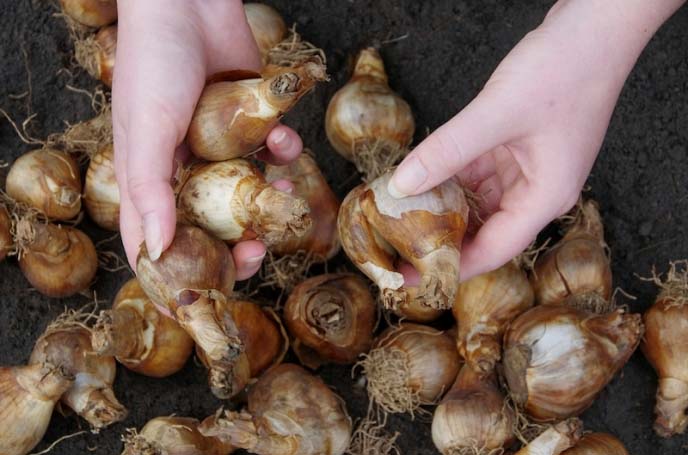

First, you need to carry out high-quality sorting of planting material and reject diseased or damaged bulbs. Sorted planting material should be sprayed Fundazol or for thirty minutes soak in a weak solution of potassium permanganate, and then let the bulbs dry. The processing of bulbs with smoke bombs shows high efficiency. "Whist". In this way, it is possible to protect the plants from bulb rot.
When determining a place for planting daffodil bulbs in the spring, remember that plants planted in spring will bloom much later than those planted in autumn.
The main condition for spring planting is the correct preservation of the planting material immediately before planting the bulbs in the open ground.
Soil and fertilizers
It is important to pay attention to the composition of the soil. Sandy loam, slightly alkaline soil is considered comfortable for tulips. To achieve this, you need to work hard in the fall. It is necessary to mix soil and ash, which will require 1 kg per 1 square meter of land. For daffodils, fertilized, fertile soil will be more favorable; in composition, it should be slightly acidic. Be sure to remember about drainage. It is important to pay attention to the fact that the groundwater flows at a depth of more than 70 cm from the surface of the earth.
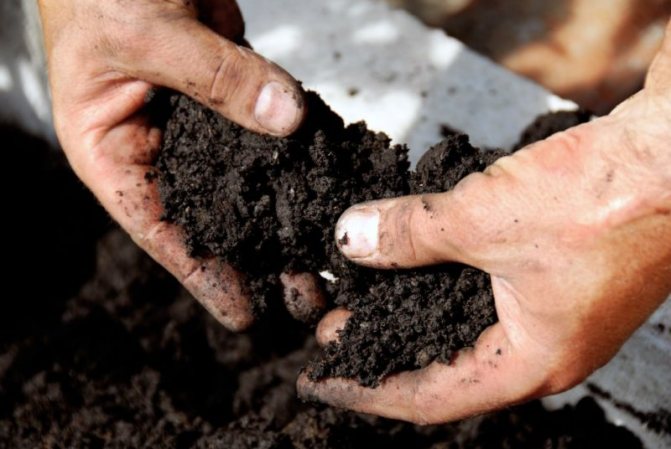

Then you can start digging up the ground. You need to dig no deeper than the bayonet of a shovel. Weed plants must be removed and, if possible, all large lumps of soil must be crushed. Having dug up the soil, then it is necessary to add fertilizers to it from humus, clay, peat and ash. For a thorough distribution of fertilizers, the soil is once again dug up and harrowed with a rake. So you need to leave everything for 2-3 days.
It is important to know that not all fertilizers are good for tulips and daffodils. So, for example, fresh manure is absolutely unacceptable for them. Bulbous plants are very sensitive, and in fresh manure there are many microorganisms that negatively affect the immunity of flowers, which leads to various diseases. You can fertilize with manure 3 years before the construction of the flower bed, or if it has fermented well.
Particular attention should be paid to the bulbs themselves. Before planting them in the ground, they must be sorted out. Throw away those affected by diseases, and leave healthy ones. For better protection from pests, healthy bulbs are dipped in a solution of potassium permanganate for 5-10 minutes. A solution is prepared at the rate of 1 g of manganese per 1 liter of water.
When planting, it is important to observe the depth: it should be three times more than the bulb itself. So, with a diameter of 3 cm, the depth should be about 9 cm. In addition, the density of the soil must also be taken into account. For example, if it is not knocked down, light, then you can plant a little deeper. If the soil is heavy enough, then, accordingly, the planting depth should be less. You can use the same formula to determine the distance between the bulbs.
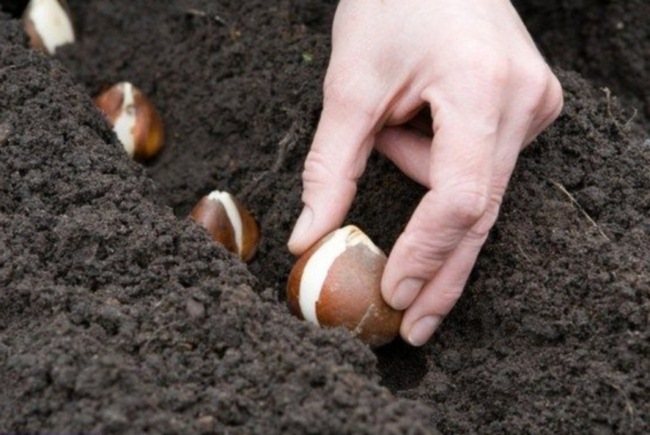

The roots of tulip and daffodil bulbs begin to grow in 13-15 days. These figures are influenced by humidity and air temperature. In order for the seedlings to appear as quickly as possible, it is recommended to do mulching - covering the soil with a protective layer of humus. The planted flower will receive additional protection from frost and additional fertilization.
Saving daffodil bulbs until spring
It is sometimes possible to plant daffodil bulbs even after all the planting dates recommended by flower growers have been missed. As a rule, before the snow falls and the onset of significant frosts, there is still a good opportunity to bury the planting material about twenty centimeters into the ground.
Narcissus bulbs retain the ability to root even at low enough temperatures, which makes late planting possible.
It is advisable to purchase planting material shortly before the moment when it is supposed to plant the plant in the ground. If the bulbs were not planted on time, then it is very important to preserve them correctly. For daffodil planting material, it is important to be in a cold and dry place, and the room itself must have good ventilation.
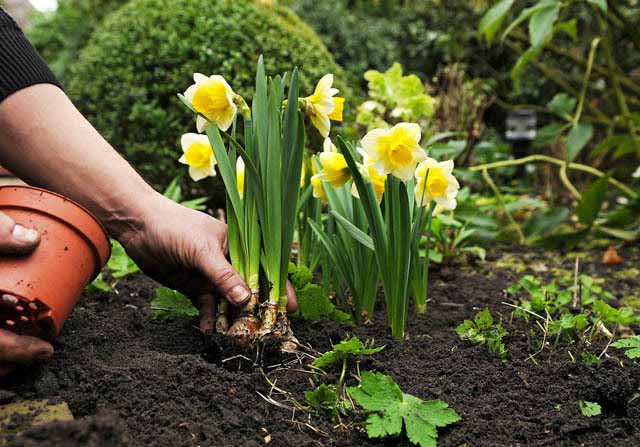

It is allowed to store bulbs on the lower shelf of the refrigerator, as well as on the shelves on the balcony, provided that the balcony room is glazed and insulated. It is forbidden to store planting material in a plastic bag, which can provoke rotting of the bulbs.
Experienced growers quite often plant the bulbs in flower pots with soil, and then in the spring, the grown plants are placed directly in the ground.
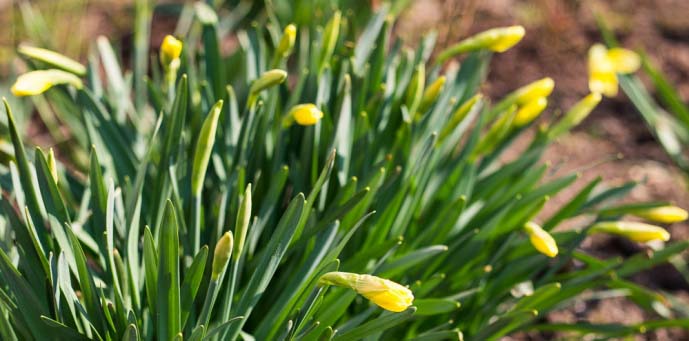

Interesting design solutions
Recently, many interesting creative ideas have appeared on how to plant tulips in an unusual and beautiful way. Let's write out a few:
1. Planting under trees. Better to give preference to fruit trees. Choose tulip varieties of the same height and matching shades. Kaufman hybrids are ideal. The bulbs should be planted in several rows or in small groups in the near-stem circle. You will get a kind of hedge.
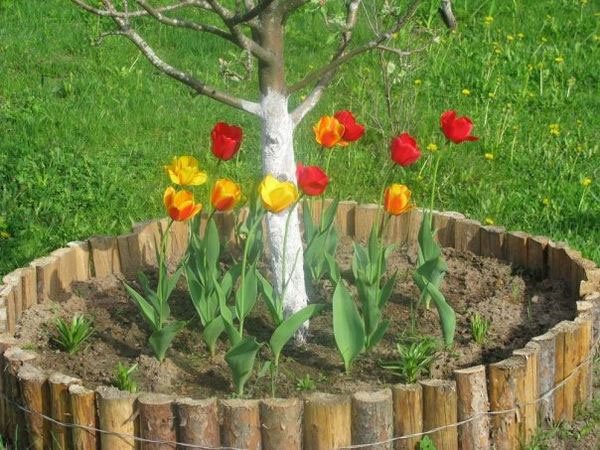

2. Compositions in pots. Portable containers with tulips will be a great addition to any design. Any varieties are suitable for such cultivation. Planting in pots helps to quickly solve the problem with landscaping the site. Plus, they can be replaced as soon as the plants have faded.
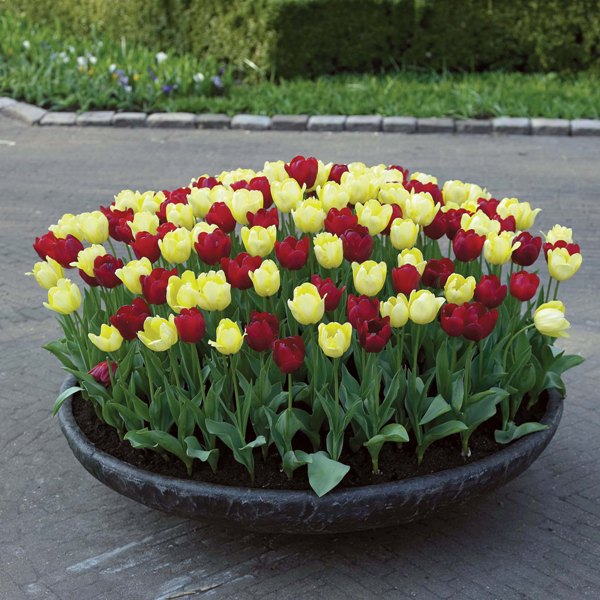

3. Combination of tulips with other bulbous flowers. In this case, you need to choose the right "neighbors". Hyacinths, forget-me-nots, daisies, pansies, primrose and muscari go well with tulips. It also looks good with shrubs such as host, ferns, forsythia, weigela and rhododendron.
You may be interested in: When to replant tulips in the garden
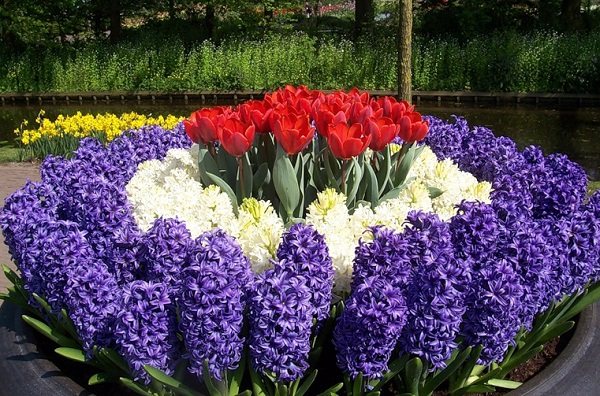

Care after spring planting
Planting daffodils in spring requires more careful and responsible plant care. Depending on the weather conditions, watering of the planting is required, and if necessary, weeding must be performed.
In the budding phase, the first feeding of plants is carried out with a mixture based on urea, superphosphate and potassium sulfate. The next fertilization should be carried out during the period of mass flowering of daffodils. For this purpose, nitrophoska is used. In addition, fertilizers can be used. "Effecton" or Agricola-7.
We also recommend that you read the article, which tells about the basic rules and principles of planting bulbs.
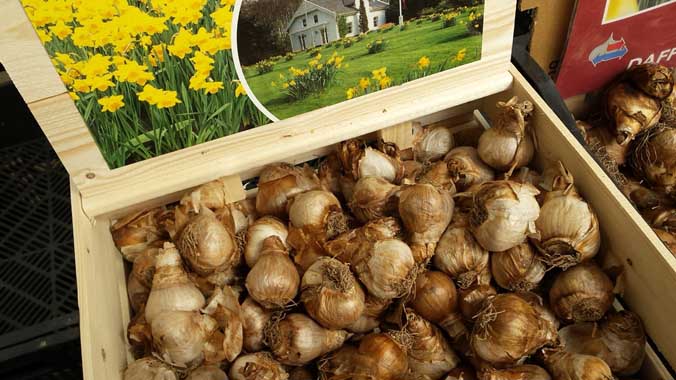

How to plant tulips correctly. Autumn planting
When to plant tulip bulbs in autumn? This is usually done from mid-September to the end of November. Such a planting time for tulips is suitable for areas of the temperate strip, Moscow region. If your region is colder, then the tulip planting dates are shifted to late August - early September. At this time, bulbs are usually planted in the regions of Siberia and the Northern Urals.
Sometimes tulips are planted in November. This should be done if the early planting was prevented by bad weather or the bulbs were bought too late. Planting tulips in late autumn is possible, but not desirable. After all, the bulbs must have time to take root before frost. This usually takes about 2 days. After that, the tulips are no longer afraid of winter. But if rooting has not happened, then the flower may disappear. It will either rot due to the abundance of moisture, which happens in late autumn, or freeze during the winter season. That is why late planting is very rarely practiced, leaning more towards the potted content of tulips until spring.
How to plant tulips correctly in autumn? To do this, decide on a place. It should be:
- sunny;
- with good air access, but no drafts;
- with good loose soil.
Tulips grow poorly in the shade. Sometimes they stop blooming even in partial shade. Therefore, it is necessary to plant them only in a bright, sunny place. It is good if this place is located at the minimum elevation. In this case, excess water will not linger at the plant root.
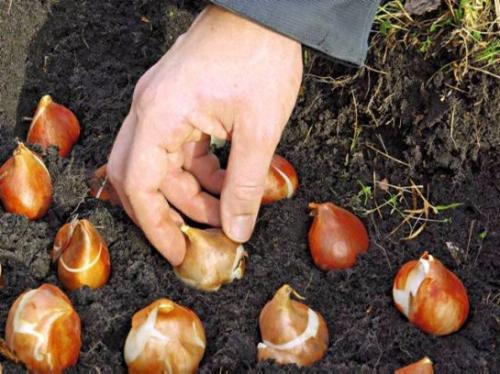

A prerequisite for planting tulips is loose soil. It can be achieved by adding sand and peat. Just dig up the bed, add additives to it, and dig again.Thus, you will get a fairly loose water and breathable soil. You can add some compost to the hole just before planting. It will provide essential nutrients to the rooting bulbs.
You can additionally fertilize the soil before planting tulips. In the fall, it is better to use nitrogen and phosphorus fertilizers. But there should be very few of them. Flowers do not need a large amount of fertilizer in autumn. Fresh manure should not be introduced, as it will certainly harm the bulbs.
How deep should tulips be planted? Tulips should be planted at least 15 centimeters deep. Sometimes gardeners dig holes 18 centimeters deep. This is important so that the bulbs can take root well, have strong shoots and survive until spring. If you plant flowers too close to the surface of the earth, they can freeze in winter and not rise at all in spring.
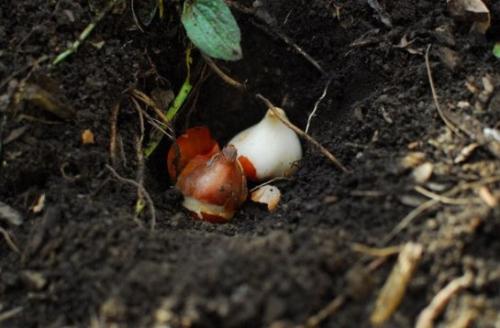

Watering when planting tulips in autumn is also important. Usually a little water is poured into the bottom of the hole. Then, two weeks after planting, it is worth moistening the soil a second time. After that, tulips are watered only in case of a very dry autumn. This is usually rare. With the onset of the first frost, it is no longer necessary to water the flowers.
It is advisable to cover the planted tulips for the winter. This will calm your conscience and stop worrying about the condition of the bulbs during frost. You can cover the flowers with hay, branches, dry leaves. It is better not to use polyethylene, as it limits the access of air to the flowers. As a result, they can start to rot in the spring. This can lead to the death of the bulbs. But the leaves and dry grass let the air through well. At the same time, they protect from frost.
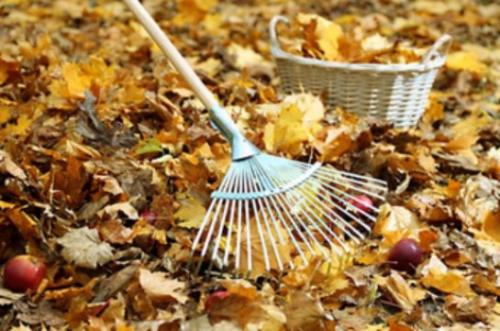

Tips & Tricks
It should be remembered that you can only dig up daffodil bulbs during a period when the leaves are completely yellow and are easily separated from the stem part. As long as the leaves on the plant are green, it is absolutely impossible to dig up daffodils, since there is an active process of accumulation of the main nutrients in the bulbs.
The bulbs dug up according to all the rules should not be left under the influence of sunlight, as too bright light can provoke the appearance of burns on the planting material. From the bulb, as well as the root system of the plant, you should very carefully, but shake off all the ground as thoroughly as possible, and then place the material in a shaded and cool place. The pre-drying period lasts no more than three weeks at a temperature of twenty-three degrees.
When to plant tulips, daffodils, lilies, crocuses and other bulbs in the fall
- How to choose good bulbs
- How to properly process bulbs before planting
- How and where to plant bulbous plants in the garden
- In what time frame do you need to plant autumn bulbous
- Can bulbs be bought late, at the end of autumn, and how to plant them?
- When to buy lilies: fall or spring?
- When to plant lilies - in spring or autumn?
- When to plant and plant daffodils
- When to plant hyacinths
- When to plant crocuses
- How to plant crocuses in the garden after forcing
- When to plant small bulbous
- When to plant tulips
- When to plant imperial hazel grouse
How to choose good bulbs
When buying tulips, daffodils, lilies and other plants, pay attention to the size of the bulb, the quality of flowering depends on it. Examine the bulbs. They should be dense, in no case wilted, not have soft rotten places, the smell of mold. Pay attention to the bottom of the bulb - it must be dry and dense, this is the key to the health and vitality of the plants. Small bulbs and plant species have smaller bulbs, this is normal.
In hyacinths, the color of the covering scales of the bulbs, as a rule, resembles the color of the inflorescences.In addition, in pink, purple, blue hyacinths, the bulbs are usually broadly conical, in yellow and orange ones, narrowly conical, and in whites they are ovoid. Varieties of different colors should have different bulbs.
It is very risky to buy lily bulbs after distillation. They are very light, as the supply of nutrients has been depleted in their scales. They do not bloom the next year. If you are attracted by the price and agree to skip two or three flowering seasons, you can buy lilies after distillation.
You need to order and pay for bulbous plants with delivery by mail in advance, so that by the planting season you have already received the parcel.
Read more about buying flower bulbs >>>.
How to properly process bulbs before planting
Free the prepackaged bulbs from the packaging at home, immediately discard the heavily damaged ones. Before planting, clean and treat newly purchased bulbs from infections. Bulbs infected with penicillus rot are often marketed, especially on tulips and lilies. The disease manifests itself in the form of gray-green sporulation on the integumentary scales of the bulb. If the penicillus spots are small, the bulb can be cured. Often on outwardly healthy bulbs, if you remove the integumentary scales, you can find the first signs of fusarium: grayish depressed spots surrounded by a brighter border. They should be removed to avoid introducing infection into the garden. Peel the bulbs, sprinkle the cuts with crushed charcoal or powdered fungicide. Let the cut dry out and slightly cork for 2-3 days.
Before planting, treat the bulbs in a liquid dressing agent (Vitaros, Maxim) according to the instructions.
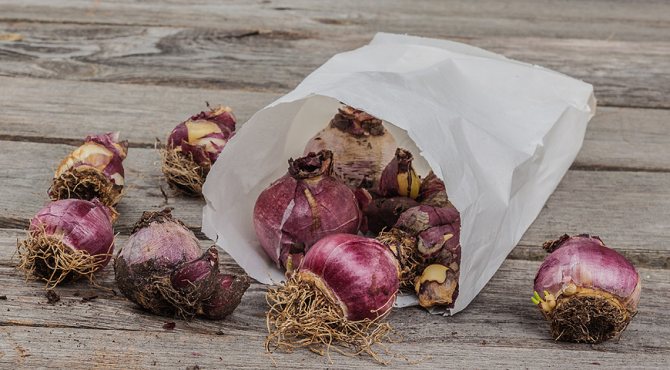

In the photo: Bulbs of hyacinths
Details about the main diseases of bulbous plants and control measures >>>.
How and where to plant bulbous plants in the garden
The planting depth of the bulb can be calculated using the “rule of three”: from the bottom to the soil surface there should be a distance equal to the height of the bulb, multiplied by 3. On heavy soil, it is better to reduce the planting depth by 20%.
During the growing season and flowering, bulbs need sun, but when they are dormant, lighting is not so important. Small-bulbous flowers blooming in early spring can be planted among deciduous trees, which bloom around the time when the foliage of these flowers dies off.
Bulbous plants do not tolerate stagnant water, but, as a rule, are demanding on the availability of nutrition and moisture during the growing season. The best choice for them is nutritious and moisture-intensive, but well-drained loamy soil. On sandy soil, additional watering and reinforced top dressing are required.
Plants whose bulbs need to be dug up for the summer (tulips, hyacinths, hazel grouses) can be planted in beds with rapidly growing annuals and biennials: nasturtiums, scented tobacco, viols, forget-me-nots, daisies. They will decorate empty spaces in the flower garden.
Check out tips for using bulbous plants in your garden design >>>
Bulb planting methods >>>.
In what time frame do you need to plant autumn bulbous
The first, in late August - early September, plant small-bulbous: scilla, muscari, pushkinia, chionodox, crocuses.
Gradually move to planting daffodils in late August to early September, then plant tulip bulbs around mid-September. It is better not to rush with planting hyacinths. The most favorable moment is the second decade of October, when the temperature reaches about + 8 ° С.
Is it possible to plant bulbs, for example, in July – August? Yes, but they begin to take root at a soil temperature of about + 10 ° C, and until that time they will lie in the ground, where onion flies, wireworms, weeds and various diseases lie in wait for them.
Read more about where and when to plant bulbous plants >>>.
Is it possible to buy bulbs late - late autumn - and how to plant them?
You can buy non-sprouted bulbs at the fall sales.Many firms offer good discounts on so-called expired bulbs. In slightly frozen soil, you can plant, for example, tulip bulbs without compromising flowering for the next year. When planting, such bulbs must be covered for the winter. Bulbous shelter should be dry and well ventilated.
To plant the bulbs in cold soil, you first need to place them in a pot with garden soil, use a drill or scrap in the frozen soil to make a sufficient deepening, put the pot, bury, mulch the planting site with peat and cover it with a covering material (spunbond, lutrasil).
If during late planting the bulbs (corms) were covered from above with spruce branches (film, non-woven material, foliage, etc.) or a large layer of compost, then in the spring, before flowering, the mulching layer must be raked off, and the covering materials must be removed.
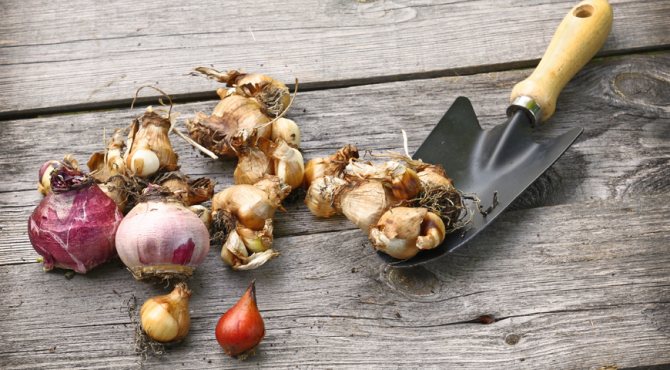

When to buy lilies: fall or spring?
The main flow of planting material comes to us from countries with a longer growing season, where bulbs are dug up in October-November. Therefore, we get a new crop in the spring, from industrial refrigerated storages. In the fall, on the shelves, as a rule, there are one-year-old bulbs ready to start growing, and sometimes even bulbs with sprouts. It is better not to buy such lilies. Therefore, it is worth buying bulbs only from local producers in autumn, and imported bulbs in spring.
Many people buy lily bulbs in winter, in January, February, when the first exhibitions begin to work. These bulbs should be refrigerated and stored in their packaging. If the sprouts grow large and continue to grow, then the bulbs should be planted in a container and kept in a bright, cool place.
Is it possible to buy lilies with sprouts? In the spring you can buy lilies with sprouts. In the fall, you should not buy lilies with sprouts. When planted, they will continue to grow and die the first time they freeze.
Look at the rules for buying lily bulbs, when is it better to do it, what to look for >>>>
When to plant lilies - in spring or autumn?
The most favorable planting time for lily bulbs is early September. The bulbs planted at this time will root perfectly and overwinter well - the bulbs are at rest and will not start growing. But in the fall it is difficult to find good planting material. Basically, they sell bulbs that have remained after the spring sale and have been in the refrigerator for almost a year.
The optimal timing for planting lilies is the end of August, September and even October. Do not plant lilies too late as they take time to root. With late planting, the bulbs do not have time to build up a sufficient mass of roots and hibernate worse.
When planting lilies late, it is better to make a shelter. Cut the branches of the bushes and arrange them over the bulbs in a "hut". Cover with oak foliage (it overheats and cakes least of all). Cover the top with an inverted vegetable drawer, then with a waterproof material (the ends of the drawer should be ventilated). Press down on the cover with heavy objects.
Lilies can also be planted in spring. When planted in spring, the bulbs bloom in the same year. But when planting in spring, you most likely have the bulbs after cold storage and when transferred to heat they grow quite quickly. Therefore, the landing time will be rather limited. You need to have time to plant the bulbs while the sprouts are still small. If they have reached 10-15 cm, then the bulbs must be planted sideways so that the sprouts can be laid in the groove next to them almost horizontally. They will gradually take an upright position and the plant will bloom in the same year, although it may be weaker. When planted in spring, the bulbs waste time growing the root system to the detriment of growth and flowering, and sometimes they simply rot the next winter.
The optimal time for planting and transplanting lilies in regions with short summers (Moscow region, Leningrad region, Ural, Siberia) is mid - late August.In the southern regions, the planting dates are shifted about a month later, in the northern ones, on the contrary, earlier.
The optimal time for transplanting and planting lilies in central Russia is August-September, in the southern regions - October. In principle, you can plant later, when the soil temperature is close to zero, but in this case you will have to cover the plants well for the winter.
See more on how to plant lilies >>>.
When to plant and plant daffodils
You need to dig up daffodils later than tulips, as soon as the foliage turns almost completely yellow (June-July), and plant earlier - until the end of September. The optimal time for planting daffodils is the second half of August, since the roots of daffodils grow most actively in September. In central Russia, daffodils are planted from about August 20 to September 1. If they are planted later, along with the tulips, they will not have time to develop the root system, which means that they will winter worse.
Daffodil bulbs planted after dry storage (without roots), it is better to mulch with fallen leaves (layer thickness of at least 10 cm), in the future this operation will not be necessary, since daffodils can grow in one place for 5-7 years. The only exceptions are split-crowned daffodils, which are mulched annually.
Secrets of growing daffodils >>>.
When to plant hyacinths
Hyacinth bulbs are planted in the conditions of central Russia (Moscow region, Leningrad, Vologda, Kostroma and other regions) and the South Urals in late September - early October. Like tulips, if they are planted too early, hyacinths can start growing and die in winter, and if they are late, they will not have time to take root before the soil freezes to the depth of planting. However, hyacinths can be planted until the first half of November. But then the place should be insulated in advance with leaves or other material from those that are at hand, and protected with a film from rain and snow. And after planting, re-lay the insulation.
Experts advise to prepare the site for planting hyacinths in August, two months before planting, otherwise the natural sediment of the soil can cause the breakage of the roots, which will begin to develop in the fall. When planting in holes, it is advisable to add well-rotted compost or peat, if it was not added during preliminary digging of the soil.
With the onset of stable cold weather, it is better to cover the planting of hyacinths. To do this, you can use dry peat, humus, sawdust, dry fallen leaves and spruce branches. In the spring, as soon as the soil begins to thaw, the shelter must be carefully removed, since hyacinth sprouts appear very early.
After spring home forcing, hyacinth bulbs can also be planted in the garden. But not in the spring, but in the fall. After the leaves wither, the bulbs must be carefully removed from the pot, dried at room temperature, and cleaned of old roots and covering scales. Store in peat, not allowing it to dry out until early September at a temperature of about + 25 ° C.
See more details on how to plant and grow hyacinths in the middle lane >>>>.
Read more about forcing hyacinths >>>.
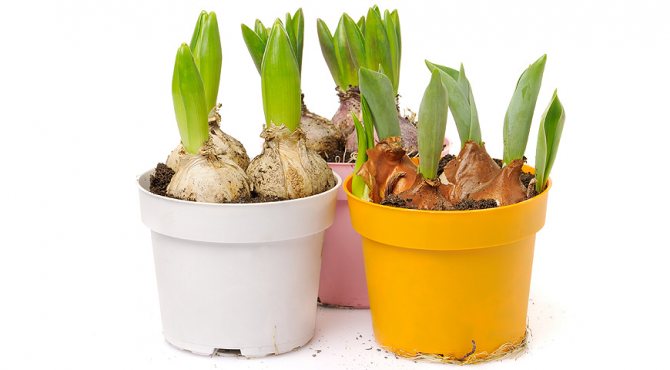

When to plant crocuses
Crocus is an early spring flower, so most of the varieties of this plant should be planted in the ground before winter, that is, in the fall, in September-October. Planting crocuses on a lawn under fruit trees, next to a water well, where the soil later freezes, will allow you to plant plants even in November. But if you want to get blooming crocuses next spring, you should order and purchase crocus corms at the end of summer.
There are also autumn varieties of crocuses, they bloom in August-September. Their bulbs should be planted in the summer (July-August). Such crocuses are more whimsical and need careful care, weeding and watering. Therefore, they are less popular than early flowering ones.When planting crocus bulbs, it is imperative to take into account their photophilousness: with a lack of light, the buds do not open.
Read more about how to plant crocus bulbs on your lawn >>>>
How to plant crocuses in the garden after forcing
Indoor crocuses - plants that have bloomed indoors in a pot - can be planted back into the garden after distillation. After flowering, remove the faded inflorescence so that the plant does not waste energy trying to seed.
Reduce watering gradually, stimulating the flow of nutrients into the bulb. When the leaves turn yellow completely, the bulb is taken out, dried at room temperature, cleaned of old roots and covering scales.
Crocus bulbs after distillation can be planted in the ground as early as May, after the soil has thawed. The plants will not bloom this season, it is unlikely that they will give full bloom next year.
Read more about forcing crocuses here >>>.
When to plant small bulbous
Small-bulbous plants (crocuses, kandyks, chionodoxes, muscari, scilla, pushkinia, corydalis, galanthus and others) may not be dug out for several years until they grow. When the plants start crowding each other, usually in June, when the leaves turn yellow, the plants are dug up, divided and replanted.
In the second half - end of August, new planting material is planted. Plants should have time to take root before the onset of cold weather. On lighter soils, the bulbs are planted a little deeper, and on heavy soils a little shallower than the standard recommended depth. Small bulbs - baby - are better buried less than adult bulbs.
When to plant tulips
The optimal time for planting tulip bulbs in central Russia (Moscow Region, Leningrad Region, Non-Black Earth Region) and regions with short summers (Ural, Siberia) falls on the end of September - beginning of October, when the soil temperature at a depth of 10 cm is about + 10 ° С, and before the soil freezes, plants have time for root formation (about 20-30 days). Plants that do not have time to root well will be undernourished and stunted. Immediately before planting, it is recommended to soak the bulbs for 30-60 minutes in a 0.5% solution of potassium permanganate or special dressing agents (for example, Maxim).
Read more about how to treat tulip bulbs from diseases before planting >>>.
In the case of a prolonged warm autumn, cover the tops of the tulips with peat with a layer of 10 cm so that the plants do not suffer from subsequent frosts.
Tulips that do not require digging for 3-6 years: Kaufman, Foster, Greig, species, as well as Darwin hybrids, Triumph, Simple early and Simple late. It is better to plant them with drought-resistant perennials with a shallow root system, for example, stonecrops. In summer, moisture is undesirable for the bulbs of such tulips. Stonecrop plantings live in the flower garden for 3-6 years, and when it comes time to dig up the bulbs, stonecrop curtains are carefully removed with a shovel, and after the tulips are harvested, they are returned to the flower garden.
More about growing tulips >>>.
Where to plant bulbous plants in the garden >>>.
When to plant imperial hazel grouse
Usually hazel grouses are planted in the garden in September-October. Forced later planting of bulbs requires mulching the planting site and covering it with oak leaves for the winter. The hazel grouse bulbs do not have covering scales, so you need to handle them as carefully as possible, to prevent drying out and mechanical damage. If it is not possible to plant hazel grouse bulbs immediately after purchase, protect them from drying out - place them in slightly damp peat or live sphagnum moss and put them in the vegetable compartment of the refrigerator.
If you already have imperial hazel grouses in your garden, then when the leaves turn yellow in summer, they must be dug up and stored in a warm, dry place until the roots appear.Usually, new roots grow on the bulb in mid-August - early September. The appearance of roots and shoots is a signal that it is time to plant the stored bulbs. At the bottom of the hole, be sure to pour a small layer of coarse river sand - this will protect the bulbs from decay.
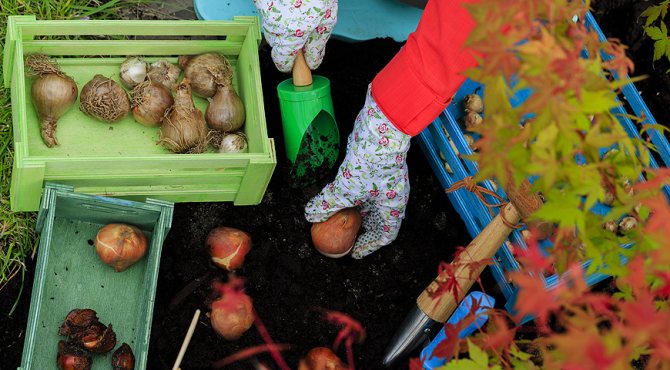

In the photo: Planting tulip bulbs
Using a duet with other colors
Tulips can peacefully coexist in the same flower bed with other plants, moreover, even the most unexpected duets at first glance give an excellent result and create stylish and original compositions. The main criterion for the selection of potential neighbors of this bulbous is the similarity in the requirements for lighting, moisture, as well as the composition and structure of the soil.
Did you know? Cut tulips do not stop growing. When in a vase of water, they can grow about another 3 cm.
Most often, tulips are planted in the same area with other bulbs. This makes it possible to dig up the bulbs after flowering, and grow annuals on the vacated territory. Tulips with daffodils look romantic and at the same time elegant on the same flower bed. The combination with crocuses and hyacinths looks very gentle and festive in spring.
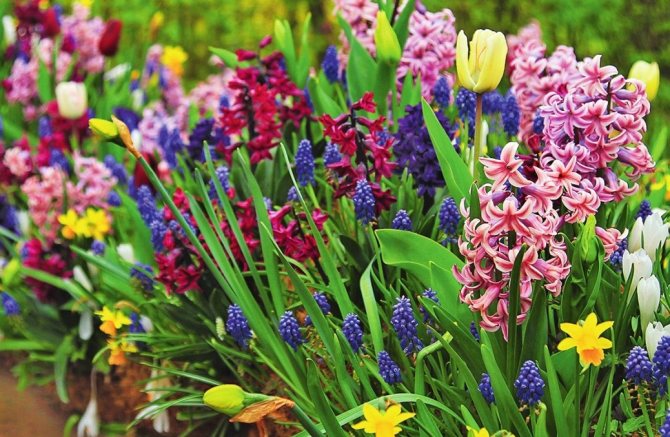

It is also recommended to place tulips in flower beds with bright and abundant annual flowers (zinnias, petunias, asters, pansies). It is important that the roots of annuals are loose and shallow so that they will not interfere with the development of the bulbs. Perennial neighbors for tulips can be hosts, peonies, gypsophila, ferns. You can also plant tulips in the foreground, when in the background there are ornamental shrubs such as weigela, rhododendron.
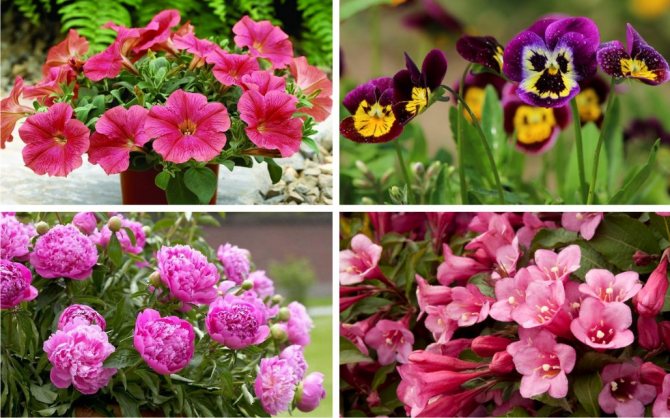

Tulips are amazing spring flowers. Despite such a short period of their flowering, many admire their beauty and diversity. With the right approach, you can create a real masterpiece of landscape design on your site.
Outdoor daffodil care
Daffodils do not require special care, it is enough to apply traditional methods of caring for garden plants in time.
Fragrant flowers love moisture. Its lack negatively affects the flowering process. The plant needs to be well watered a couple of times a week from the moment the first shoots appear. In order for the bulb to absorb the nutrients necessary for growth, watering must be continued after flowering, until the plant completely withers away.
Also periodically you need to do weeding and loosen the soil of the flower garden. This will get rid of weeds and help reduce moisture evaporation. Dried faded flowers should be removed so that they do not unnecessarily take away the strength of the roots.
In the spring, daffodils are fed with ammonium nitrate. This nitrogen fertilizer has a beneficial effect on all processes in the life of a plant, especially on the growth of green mass. Phosphorus and potassium are added before flowering - this contributes to the formation of buds and active reproduction of bulbs.
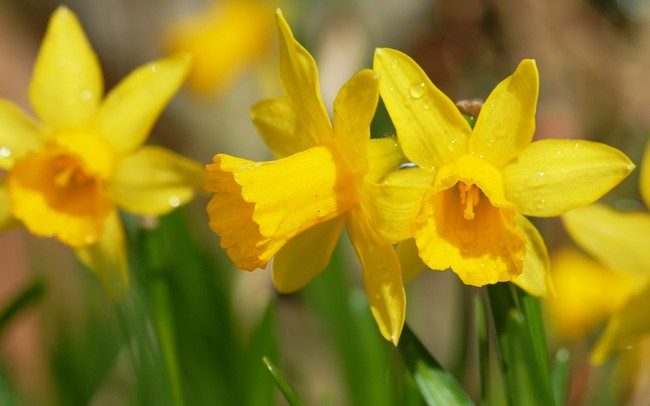

Fresh articles for gardeners, gardeners and florists
Treatment of trees in the spring from pests and diseases
Pruning trees in spring for beginners in pictures step by step
Spring processing of trees and shrubs from pests and diseases
Tomato picking in April 2020 according to the lunar calendar
Planting bulbs
To plant daffodils, you need to know a simple rule. The bulb is buried to a depth equal to its height multiplied by 3. It is also important to take into account the quality of the soil in which we plant the bulbs.
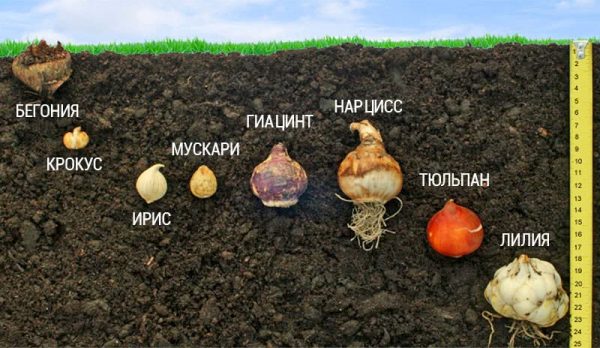

As a rule, the depth of the hole is about 12-25 cm. For example, if the soil is heavy, then the bulb is buried only 10 cm or a little more. If the soil is light, it is recommended to deepen the daffodil by 22-24 cm. The distance between the bulbs when planting daffodils also depends on their size. These flowers look great when grown side by side. But when planting, you cannot make holes closer than 10 cm from each other.Otherwise, the flowers will interfere with each other. It is best to keep a distance of about 20 cm.
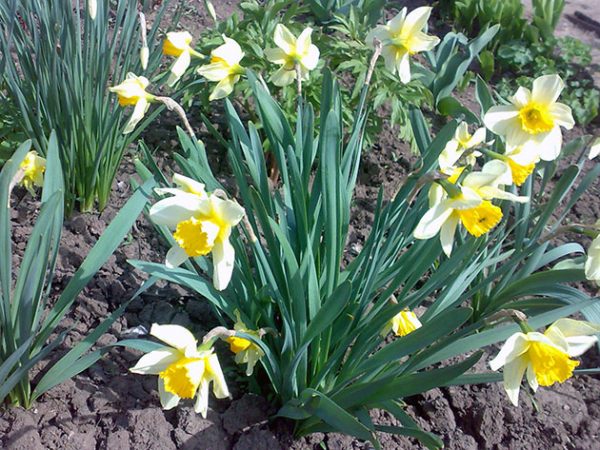

Before planting a daffodil, you need to carefully dig up the soil. If necessary, it is well loosened, sand is added. Only after that, holes of the required depth are dug for the bulbs, which depends on the size of the bulb itself. A little sand is poured into each hole at the bottom to provide additional drainage.
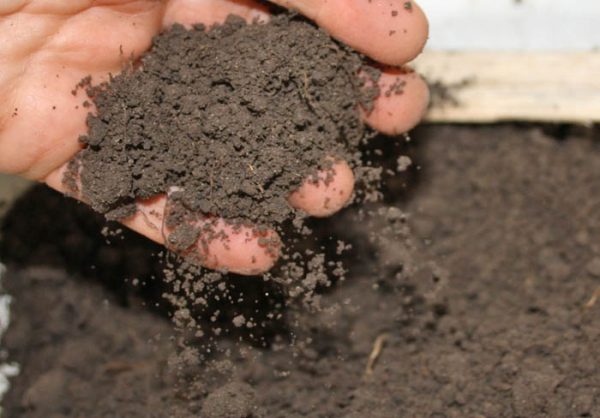

The bulbs need to be watered and then covered with soil. When it gets cold, a layer of mulch is added in the form of peat or leaves.
Creation of landscape design
How the flower beds will look in spring, after the bulbs awaken, need to be thought out in the fall. Care should be taken to install wrought-iron and wicker fences, masonry, paved paths, fountains and other attributes in order to create not only flower beds, but also mixborders, rabatki, alpine slides, rocky gardens.
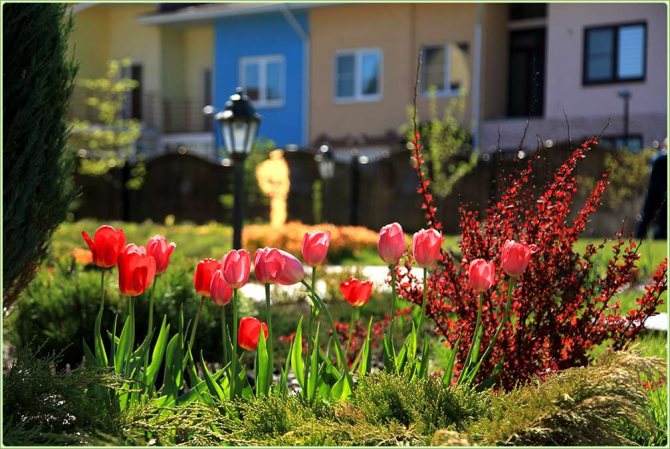

If novice gardeners do not yet have a collection of bulbs of other crops for developing planting schemes, and they do not know what to plant tulips with in a flower bed, we recommend that you consider creating Moorish lawns where bulbous crops can be combined with cereals with wide leaves. You can create separate groups of bulbous, place in the near-trunk circles of trees and large bushes. In public gardens and parks, landscape designers plant entire tracts and arrange huge "festivals" of tulips, presenting all their splendor and diversity.
Let's take a closer look at how to distribute tulips in the garden, create a landscape design using some schemes.
Rows of tulips
Bulbous plants are planted in a row if the garden plot is divided into zones where individual compositions and elements are repeated, that is, a regular and landscape garden is created and formed. Each section (zone) must have the correct geometric shape. On each of the square mini-flower beds, a culture of the same variety and color, the same flower shape and texture is planted. Then the composition will consist of different bright areas. It is fashionable to alternate tulips in a rectangular flower bed with other plants blooming in the same period of time, for example, with daffodils, creating a border.
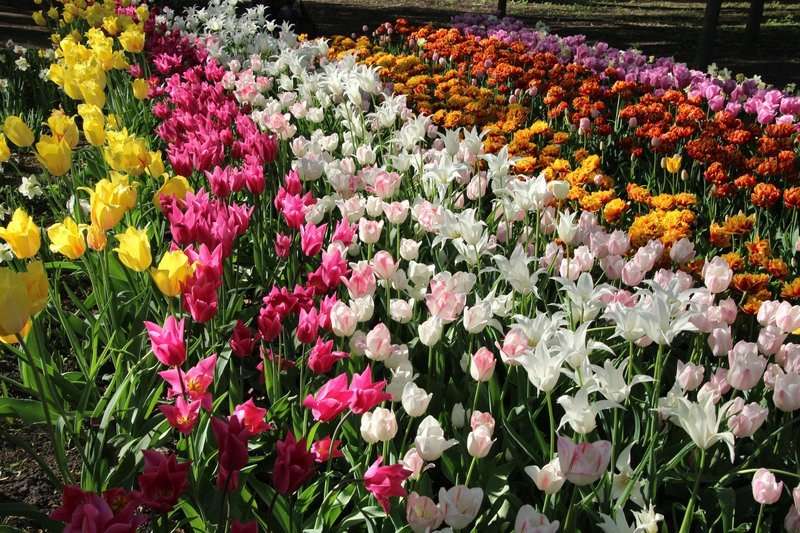

Curb landings
Bulbous planting is most common. It is important here to combine tulips with other flowers on the flowerbed (border), because after the flowering of the bulbous flower is completed, the flowerbed will lose its spectacular appearance, especially with the lower wilting and drying plant leaves. They are left so that the bulbs gain strength and develop, and after transplanting in the fall for the next season in the spring, they gave new healthy buds and greens.
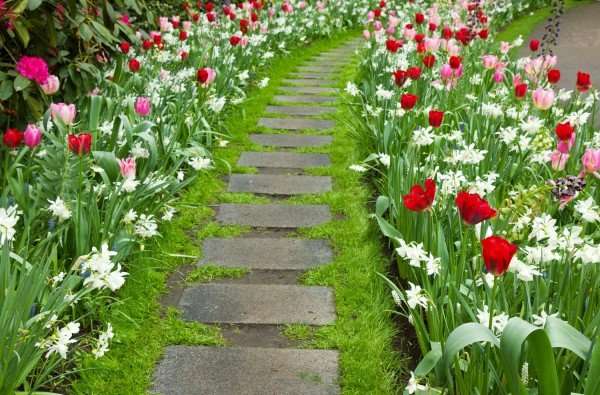

Annual or perennial crops are planted that bloom after tulips. The dug out bulbs are replaced with annual seedlings, while perennial flowers will cover the drying leaves of tulips and "save" the beauty and contours of the borders.
Planting in groups
Group plantings always look more spectacular if the tulips are of the same color. If you mix different varieties, then the flower bed turns into a vinaigrette. If tulips are scattered one by one throughout the area among other flowers, then they will be invisible even when they are magnificent. Beds with tulips in the country can be made contrasting: one bright color spot should smoothly transition from one tone to another. Monochrome flower beds of one-color tulips acquire an attractive appearance, but the varieties should be different: simple and double, simple and fringed, simple and lily-colored, etc.
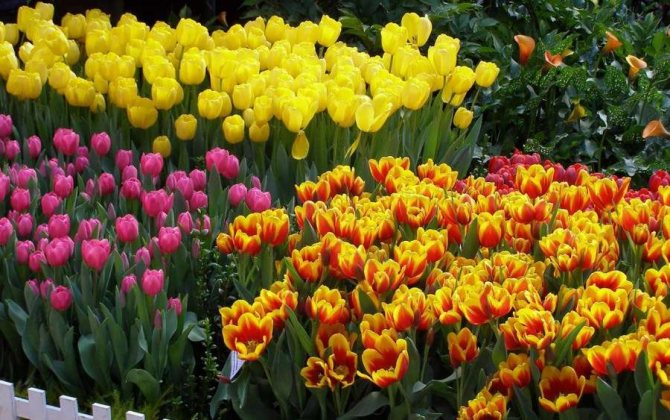

Planting plants of the same height
To organize a flower bed of crops of different heights, the background is planted with bulbs with high stems, the middle part with a culture with medium flower stalks, the foreground with dwarf tulips and other low-growing species of flowering bulbous. The flower bed can be multi-level or stepped, where the flowers do not overlap.
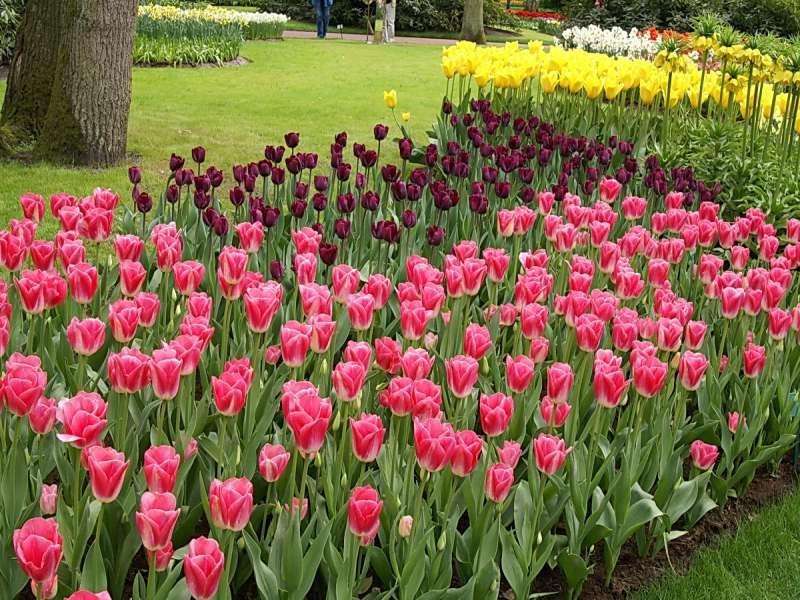

Planting according to flowering dates
Planting plants of different varieties and species with different flowering periods prolongs the life of the flower garden. For example, first, you can admire early simple and double tulip varieties, as well as wild tulips, the flowering time of which begins in April. Behind them, in early May, mid-flowering crops will bloom and late ones - from the second half of May.
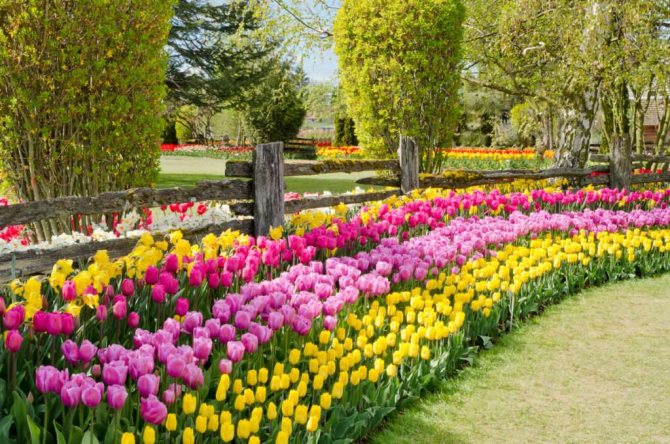

Decoration of meadows and mini-lake
On the backyard area, you can organize a trickle from the fountain and a lake (pond). Fountains can be in the form of a steady stream, a hemisphere, a tulip, a bell, a ring, or a fish tail. The pond can be round, elliptical, square, heart-shaped and other shapes with grooves for planting flowers. Everything is lined with stones, gravel, and some areas are planted with plants farther or closer to the water, due to their preferences for moisture. Some plants grow directly in the water of the mini-lake, in shallow water or on the shore, in the shade or in the sun. Tulips of the same color are planted in groups.
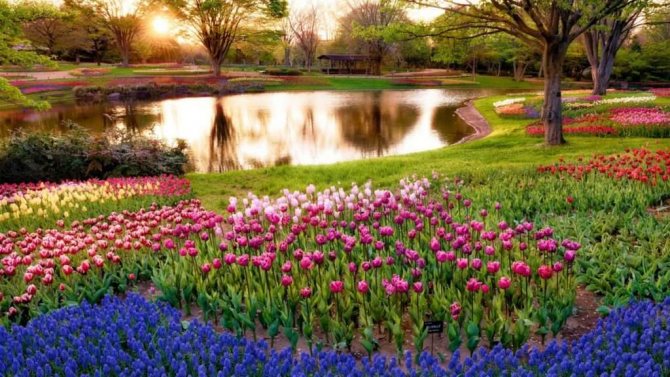

Important... To preserve the bulbs, you need to plant them away from the jets of the fountain, and equip the fountain and the lake in a separate recreation area - away from trees, shrubs, hedges, playgrounds, buildings and garden furniture. Ponds should be protected from clogging with fallen leaves.
Tulips
And the frost is not terrible!
Tulips are perhaps the toughest bulbous you can think of. They cannot stand only one thing - being locked up. And this is not surprising, considering that even luxurious Dutch varieties continue to preserve the memory of their distant homeland - steppes, deserts and mountains. And there are frequent and snowless severe frosts, and unstable weather, and winds, and drought. But the sun is in abundance! Based on this, and it is necessary to choose a place for planting them - it can be blown, with poor rocky soil, but always well lit.
By the way, if on occasion you got not too dry tulip bulbs in October, November and even in January, take it. You can plant them at any time, if the soil is still amenable to shoveling. Or, if the snow has already fallen, you can simply rake it to the ground, spread the bulbs and sprinkle with any earthen mixture (however, you will have to bring it with you). The soil layer can be quite small - there are many cases when dug up tulips, abandoned in a garden or path, successfully wintered "naked".
True, there is one but. Such "extreme" actions are good when saving plants and preserving the variety is more important than getting perfect flowering in the coming spring. For purely decorative purposes, purchase sized bulbs and plant them on time.
